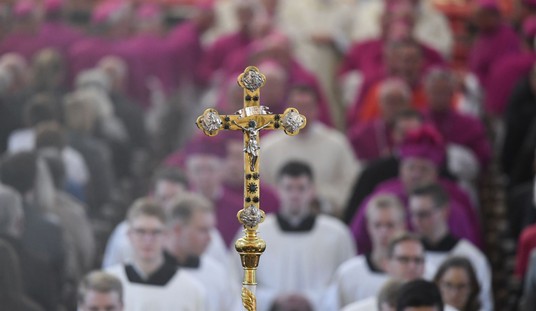Editor's Note: This is an exclusive excerpt adapted from "The Cost of My Faith: How a Decision in My Cake Shop Took Me to the Supreme Court" by Jack Phillips, releasing May 25, 2021 (Salem Books).
The gavel came down. A door opened behind the bench, the red curtains were swept aside, and the nine justices filed into the room, taking their seats with barely a glance toward the waiting audience.
The justices sit in order of seniority: Chief Justice John Roberts at the center, the longest-serving justice to his right, the second-longest serving to his left, and back and forth, in that order. Neil Gorsuch, then the most newly appointed of the nine, sat on the far-left end.
Across the rest of the bench sat Associate Justices Ruth Bader Ginsburg, Stephen Breyer, Samuel Alito, Sonia Sotomayor, Elena Kagan, Anthony Kennedy, and Clarence Thomas. A formidable array of remarkable legal minds. How would they choose to look on my case?
We were about to find out.
Recommended
The court marshal let forth the words he uses to open every session of the U.S. Supreme Court:
“The Honorable, the Chief Justice and the Associate Justices of the Supreme Court of the United States. Oyez! Oyez! Oyez! All persons having business before the Honorable, the Supreme Court of the United States, Oral Arguments are admonished to draw near and give their attention, for the Court is now sitting. God save the United States and this Honorable Court!”
And with that, we were off to the races.
Roberts got right to the point. “We’ll hear argument this morning in Case 16-111, Masterpiece Cakeshop versus Colorado Civil Rights Commission. Ms. Waggoner.”
Kristen stepped up to the podium.
“Mr. Chief Justice, and may it please the Court,” she began. “The First Amendment prohibits the government from forcing people to express messages that violate their religious convictions. Yet the commission orders Mr. Phillips to do just that.”
And that, of course, was our entire argument in a nutshell: that I shouldn’t be forced to design and create custom cakes that celebrate same-sex marriage when I believe the Bible defines marriage as between one man and one woman.
It was a good thing that Kristen got such a clear, concise summary of our argument out of the way so quickly. Before she could utter another word, the justices hit her with a barrage of questions.
She was facing what attorneys like to call a “hot bench.” The justices’ questions tumbled over each other as they leaned into their microphones, interrupting, raising their voices, jockeying for their place in the interrogation queue. Only Justice Thomas sat apart from all this, leaning back in his chair, watching and maintaining his customary silence.
At moments, it felt more like a middle school dodgeball game than the dignified atmosphere of the nation’s highest court. Kristen hardly had time to breathe, let alone finish her opening statement. But she rose wonderfully to the challenge. She fielded the rapid-fire questions coming in from all directs with poise and a level tone. She was quick, accurate, compelling, and—I thought—convincing.
I realized, not for the first time, that I had a very good lawyer.
She and the other attorneys had told me to be listening for one particular question that they expected the justices not only to ask but to press especially hard: In my case, does a custom cake designed to celebrate marriage constitute “speech”?
They were right. That turned out to be exactly the question on many of the justices’ minds. Ginsburg wanted to know whether anyone could buy a cake off my shelf. When Kristen said yes, Kennedy wondered whether that kind of cake constituted speech.
Ginsburg still wanted clarity about who I’d sell to and what I’d sell.
“You’re not challenging his obligation to sell his ordinary wares, his already-made wares?” she asked.
"Not at all,” Kristen said. “Mr. Phillips offered the couple anything in his store, as well as offered to sell additional cakes, custom cakes, that would express other messages.” I was really glad she had the chance to explain that specific point, because it was such an important part of the case for me. It really defined my culture of welcome.
I wanted the justices—and all the Americans who would read about these arguments—to understand I welcomed everybody into my shop.
Ginsburg followed with yet another question. “At a wedding ceremony, I take it, the speech is of the people who are marrying and perhaps the officiant, but...who else speaks at a wedding?”
“The artists speak, Justice Ginsburg,” said Kristen. “It’s as much Mr. Phillips’s speech as it would be the couple’s.” She was trying to make it clear that my custom cakes remain my speech even when someone pays me to create them.
From there the questions started running even faster in every direction.
But that one key question kept coming up again and again, in one form or another—what is speech? Can a custom cake (or any other work of art, architecture, or design) be protected under the heading of “free speech”—that is, the First Amendment?
“Certainly not all cakes would be considered speech,” Kristen said, “but in the wedding context, Mr. Phillips is painting on a blank canvas. He is creating a painting on that canvas that expresses messages, including words and symbols in those messages.”
Phillips is the owner of Masterpiece Cakeshop in Loveland, Colorado.



